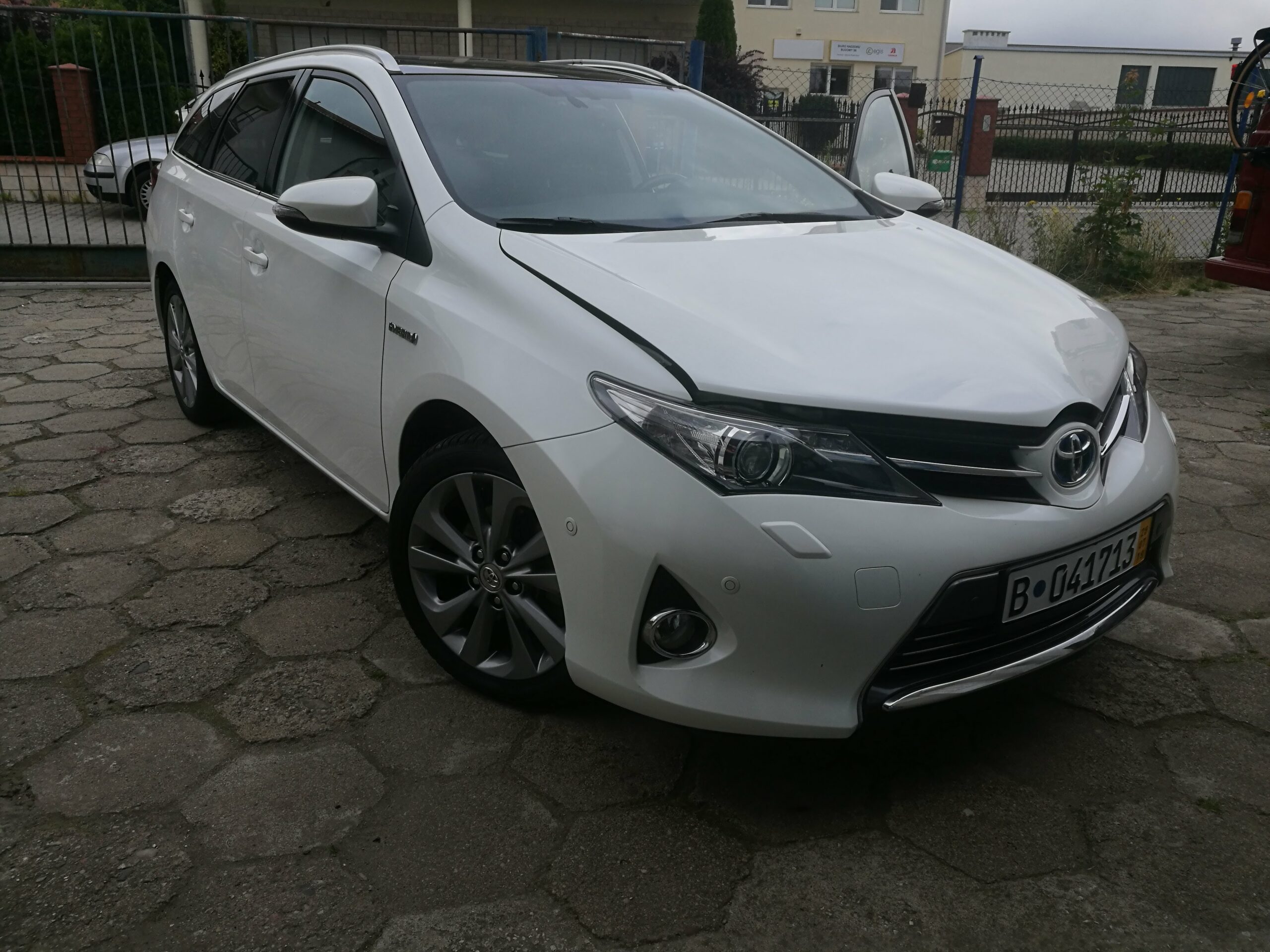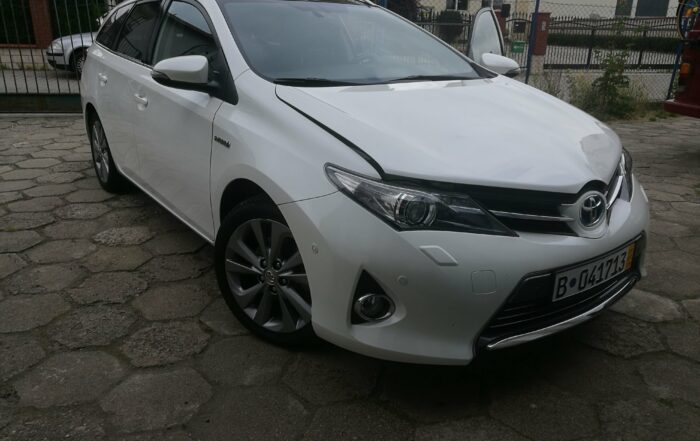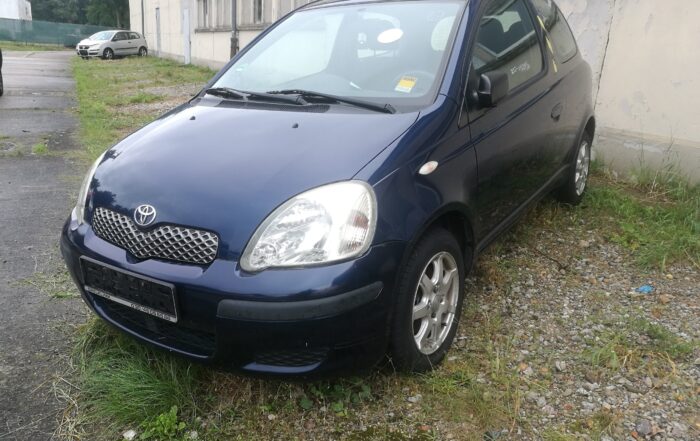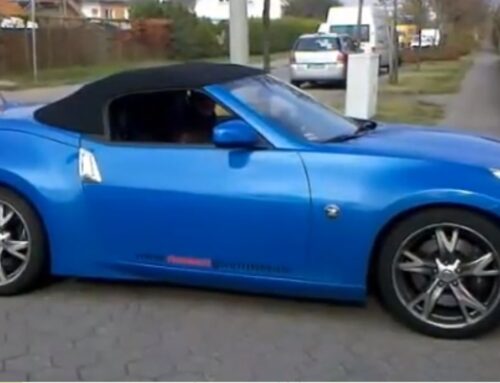POV Video
Test Video
History
The Toyota Auris Touring Hybrid E180 is a remarkable car that has grown from humble beginnings into a symbol of innovation and efficiency in the automotive industry. In order to truly understand and appreciate this model, it is essential to delve into its history and development.
The Toyota Auris, first introduced in 2006, was initially positioned as a compact hatchback designed to compete against the likes of the Volkswagen Golf and Ford Focus. It aimed to offer a reliable and practical transportation solution for everyday commuting, while also showcasing Toyota’s commitment to environmental sustainability.
However, it was in 2010 that the Auris truly made a mark in the automotive world with the introduction of the hybrid variant. Toyota’s pioneering hybrid technology, already successful with the Prius, was now available in a more conventional and affordable package. This marked the birth of the Auris Hybrid, which quickly gained popularity among environmentally conscious drivers.
The second generation of the Toyota Auris was unveiled in 2012, with a sleeker design and enhanced features. The Auris Touring Sports, introduced in 2013, further expanded the range by offering a hybrid variant with an estate body style. This allowed for increased cargo capacity and versatility, making it an ideal choice for families or those seeking a practical and fuel-efficient vehicle.
The Auris Touring Hybrid E180, which debuted in 2015, represented yet another leap forward in the development of the model. This version featured improved aerodynamics, further optimizing fuel efficiency and reducing emissions. Its hybrid powertrain combined a petrol engine with an electric motor, allowing for seamless transition between the two sources of power and maximizing fuel economy.
One notable feature of the Auris Touring Hybrid E180 is its regenerative braking system, which recovers energy lost during braking and stores it in the vehicle’s battery. This energy is later used to power the electric motor, reducing reliance on the petrol engine and further improving fuel efficiency.
In terms of technology and safety features, the Auris Touring Hybrid E180 was equipped with the latest advancements at the time of its release. This included a touchscreen infotainment system, advanced driver assistance systems such as lane departure warning and automatic emergency braking, as well as a comprehensive airbag system for enhanced passenger protection.
Throughout its history, the Toyota Auris Touring Hybrid E180 has continuously evolved to meet the changing demands of drivers and the automotive landscape. It has become synonymous with fuel efficiency, reliability, and excellent build quality. By combining Toyota’s renowned hybrid technology with a practical estate body style, it has carved a niche for itself in a highly competitive market.
The development of the Toyota Auris Touring Hybrid E180 showcases Toyota’s commitment to sustainability and innovation. It is a testament to the brand’s ongoing efforts to create vehicles that not only meet the needs of modern drivers but also minimize the impact on the environment. Whether for its efficiency, practicality, or eco-friendly credentials, the Auris Touring Hybrid E180 remains a compelling choice for those seeking a reliable and environmentally conscious vehicle.
Design
The Toyota Auris Touring Hybrid E180 was designed by a team led by Chief Engineer, Takahiro Kunimoto. The inspiration behind the car’s design was to create a stylish and versatile hybrid vehicle that offers both comfortable everyday driving and a spacious cargo area.
In terms of design language, the Toyota Auris Touring Hybrid E180 follows the brand’s “Keen Look” design philosophy. This design philosophy focuses on creating a bold and dynamic appearance, characterized by sharp, angular lines and a distinctive front grille. The car features sleek headlights and taillights, giving it a modern and sophisticated look.
Overall, the design of the Toyota Auris Touring Hybrid E180 blends functionality with a hint of sportiness, creating a visually appealing and practical hybrid vehicle.
Model overview
The Toyota Auris Touring Hybrid E180, also known as the Toyota Corolla Touring Sports in some markets, offers a range of variations to cater to different preferences and needs. Here are some of the notable variations of the Toyota Auris Touring Hybrid E180:
1. Trim Levels: The Auris Touring Hybrid E180 is available in multiple trim levels, including entry-level options and higher-end trims with more features and technology. Common trim levels include the Active, Icon, Design, Excel, and more.
2. Engine Options: As the name suggests, the Auris Touring Hybrid E180 comes with a hybrid powertrain as standard. It combines a 1.8-liter petrol engine with an electric motor to deliver a balance between performance and fuel efficiency. This hybrid system delivers impressive fuel economy figures and low emissions.
3. Transmission: The hybrid powertrain of the Auris Touring Hybrid E180 is mated to an electronically controlled continuously variable transmission (CVT), providing smooth and efficient power delivery. CVT allows the engine to operate at the most optimal RPM range for better fuel efficiency.
4. Drive Options: The Auris Touring Hybrid E180 is primarily a front-wheel-drive vehicle, providing balanced handling and traction on various road conditions. However, specific markets may offer an all-wheel-drive option for enhanced stability and control.
5. Features and Technology: The Auris Touring Hybrid E180 is equipped with various features and technologies to ensure a comfortable and convenient driving experience. These may include a touchscreen infotainment system, advanced driver assistance systems, keyless entry, dual-zone climate control, panoramic sunroof, leather upholstery, and more. The availability of these features may vary depending on the chosen trim level.
6. Design: The Auris Touring Hybrid E180 features a stylish and contemporary design, following Toyota’s modern design language. It boasts aerodynamic lines, LED lighting, and a spacious interior with ample cargo space for practicality.
It’s worth noting that variations may differ depending on the market and specific model year. It’s always recommended to check with local Toyota dealerships or the official website for accurate and up-to-date information on the available variations of the Auris Touring Hybrid E180 in your area.
Everyday use
The Toyota Auris Touring Hybrid E180 is a practical choice for everyday use. Its hybrid powertrain combines a 1.8-liter petrol engine with an electric motor, providing an efficient and smooth driving experience. The hybrid system not only enhances fuel economy but also reduces emissions, making it an environmentally friendly option.
The Auris Touring Hybrid E180 offers ample space and comfort for both passengers and cargo. The rear seats can be easily folded down, providing a spacious loading area for larger items. With its compact size, it is easy to maneuver in urban environments and navigate through tight parking spaces.
In terms of features and technology, the Auris Touring Hybrid E180 comes equipped with modern conveniences such as a touchscreen infotainment system, Bluetooth connectivity, and a rearview camera. Advanced safety features, including lane departure warning and automatic emergency braking, are also available in certain trims.
The hybrid system ensures a quiet and smooth ride, making it an ideal choice for daily commutes or long journeys. The fuel efficiency of the hybrid powertrain means fewer trips to the gas station, and the reliability of Toyota vehicles is well-known, reducing the likelihood of unexpected breakdowns or repairs.
Overall, the Toyota Auris Touring Hybrid E180 offers a practical and reliable option for everyday use. Its fuel efficiency, spacious interior, and modern features make it a versatile choice for both urban driving and longer trips.
Trunk
The Toyota Auris Touring Hybrid E180 offers a decent amount of trunk space for a compact hybrid. It has a cargo capacity of 507 liters (17.9 cubic feet) with the rear seats in place. With the rear seats folded down, the capacity increases to 1,486 liters (52.5 cubic feet), providing ample room for larger items or luggage. This makes it a practical choice for those who require a spacious trunk for their everyday needs or occasional trips.
Interior
The Toyota Auris Touring Hybrid E180 boasts a high-quality interior with a focus on comfort and durability. The materials used in the cabin are well-chosen, providing a pleasant and refined atmosphere.
The upholstery in the Auris Touring Hybrid E180 is typically made from a combination of fabric and synthetic materials. The seats are cushioned and supportive, ensuring a comfortable ride even on longer journeys. The dashboard and door trims are crafted with a mix of soft-touch plastics and textured materials, giving a premium look and feel.
In terms of overall build quality, Toyota has paid attention to detail, with tightly fitted panels and minimal gaps throughout the interior. This attention to detail enhances the feeling of solidity and durability.
Furthermore, the Auris Touring Hybrid E180 incorporates various technological features, such as a touchscreen infotainment system, climate control, and a multifunction steering wheel. These elements are seamlessly integrated into the cabin, adding to the overall appeal and functionality of the interior.
Overall, the interior of the Toyota Auris Touring Hybrid E180 is well-crafted, offering a pleasant blend of comfort, quality materials, and modern technology.
Safty
The Toyota Auris Touring Hybrid E180 comes equipped with a range of safety features to ensure the safety of its passengers. Some of the key safety features include:
1. Pre-Collision System: This system uses radar and camera to detect potential collisions and alerts the driver. It can also automatically apply the brakes to reduce the impact of a collision.
2. Lane Departure Alert with Steering Control: This feature warns the driver if the vehicle starts to drift out of its lane and can even apply corrective steering input to keep the car within the lane.
3. Adaptive Cruise Control: This system maintains a set distance from the vehicle ahead and automatically adjusts the car’s speed to maintain a safe following distance.
4. Road Sign Assist: This feature uses a camera to detect and display road signs on the vehicle’s display, ensuring that the driver is aware of important information such as speed limits or overtaking restrictions.
5. Automatic High Beam: This system automatically switches between high and low beams based on detection of oncoming or preceding vehicles.
The safety rating of the Toyota Auris Touring Hybrid E180 can vary based on different regions and testing agencies. In Europe, for example, the Auris Touring Hybrid E180 was tested by Euro NCAP (European New Car Assessment Programme) and received a 5-star safety rating, which is the highest possible rating. However, it is important to note that safety ratings may differ depending on the specific model and variant being tested. It is always advisable to refer to the safety ratings provided by your local automotive safety testing agency for the most accurate and up-to-date information.
Maintenance Costs
The costs for maintenance, insurance, and general upkeep of a Toyota Auris Touring Hybrid E180 can vary depending on several factors such as location, driving habits, and insurance providers. However, here is a general overview of the estimated costs:
1. Maintenance:
Toyota vehicles are known for their reliability and generally have lower maintenance costs compared to some other brands. Routine maintenance tasks such as oil changes, tire rotations, and brake inspections are usually affordable. However, it is advisable to follow the manufacturer’s recommended maintenance schedule to ensure the longevity of your vehicle and prevent costly repairs in the future.
2. Insurance:
Insurance premiums for a Toyota Auris Touring Hybrid E180 will depend on various factors including your age, driving record, location, and the coverage options you choose. Hybrid cars often qualify for discounts due to their fuel efficiency and eco-friendliness. It is recommended to obtain insurance quotes from different providers to find the best coverage and rates that suit your needs.
3. General Upkeep:
General upkeep costs for the Toyota Auris Touring Hybrid E180 typically include expenses for fuel, tires, and regular servicing. Fuel costs will depend on your driving habits, the current fuel prices, and the distance you cover. Hybrid vehicles generally have better fuel economy compared to traditional petrol or diesel cars, which can help reduce your fuel expenses. Tires should be replaced periodically and their price may vary depending on the brand and size. Regular servicing, including replacement of parts such as air filters, oil filters, and brake pads, is essential for maintaining optimal performance and will add to the general upkeep costs.
It is important to note that these estimated costs are general guidelines, and actual expenses may differ based on individual circumstances. It is recommended to consult with local Toyota dealerships, insurance providers, and online resources to get accurate and up-to-date information specific to your location and circumstances.
Fuel Consumptions
The Toyota Auris Touring Hybrid E180 is known for its excellent fuel efficiency. It has an official fuel consumption rating of around 3.6-4.1 liters per 100 kilometers, or approximately 65-72 miles per gallon. This makes it one of the most fuel-efficient cars in its class. Keep in mind that actual fuel consumption may vary depending on various factors such as driving conditions, driving style, and vehicle maintenance.
Motor Layout
The Toyota Auris Touring Hybrid E180 is equipped with a hybrid powertrain, combining a gasoline engine with an electric motor. The engine layout is a transverse front-engine, which means the engine is positioned horizontally at the front of the vehicle. The hybrid powertrain in the Auris Touring consists of a 1.8-liter four-cylinder gasoline engine paired with an electric motor. This combination offers a total system output of 134 horsepower.
As for the transmission, the Auris Touring Hybrid E180 utilizes an electronically controlled continuously variable transmission (eCVT). The eCVT is designed to provide smooth and seamless gear shifts, allowing for optimal fuel efficiency and a refined driving experience. The electric motor assists the gasoline engine during acceleration and low-speed driving, reducing fuel consumption and emissions.
Motor
The Toyota Auris Touring Hybrid E180 was offered with two engine options:
1. 1.8-liter Hybrid Engine: This engine combines a 1.8-liter gasoline engine with an electric motor. It produces a combined power output of around 134 horsepower. The hybrid system allows for seamless transitions between gasoline and electric power, providing a fuel-efficient driving experience.
2. 1.2-liter Turbocharged Gasoline Engine: In some markets, the Auris Touring was available with a 1.2-liter turbocharged gasoline engine. This engine produces around 114 horsepower and offers a more conventional powertrain option for those who prefer a traditional gasoline engine.
Both engine options in the Auris Touring Hybrid E180 provide a good balance of power and fuel efficiency, catering to different driving preferences and needs.
Transmission
The Toyota Auris Touring Hybrid E180 was offered with a Continuously Variable Transmission (CVT). This type of transmission is commonly used in hybrid vehicles as it allows seamless shifting between gears for optimal fuel efficiency. The CVT in the Auris Touring Hybrid E180 ensures smooth acceleration and efficient power delivery.
Breaks
The Toyota Auris Touring Hybrid E180 is equipped with a set of braking systems to ensure safe and efficient stopping power. The specific brake components used may vary depending on the model year and trim level. However, the Auris Touring Hybrid typically comes with disc brakes on all four wheels.
Disc brakes work by using calipers to squeeze brake pads against a rotating disc, also known as a rotor. This friction between the pads and the disc creates the necessary resistance to slow down or stop the vehicle. Disc brakes are commonly preferred for their consistent performance, excellent stopping power, and ability to dissipate heat effectively, reducing the risk of brake fade.
In addition to regular disc brakes, the Toyota Auris Touring Hybrid may also incorporate various supplementary braking technologies such as regenerative braking. Regenerative braking harnesses the kinetic energy produced during deceleration or braking and converts it into electrical energy, which can be stored in the hybrid battery for later use. This system helps improve fuel efficiency and reduces wear on traditional friction brakes.
Suspension
The Toyota Auris Touring Hybrid E180, which was produced from 2012 to 2018, featured a front suspension system called MacPherson strut, while the rear suspension was a torsion beam setup. These suspension systems were designed to provide a comfortable ride and good handling characteristics for the vehicle.
Common Issues
The Toyota Auris Touring Hybrid E180 is a popular choice among eco-conscious drivers, thanks to its hybrid powertrain and impressive fuel efficiency. However, like any other vehicle, it is not without its weaknesses and common issues. Here is a detailed overview of some of the weaknesses you may encounter with the Toyota Auris Touring Hybrid E180:
1. Lack of power: While the hybrid powertrain provides exceptional fuel efficiency, it sacrifices power and acceleration. The 1.8-liter engine combined with the electric motor produces a modest 134 horsepower, which may feel underwhelming for those expecting a more spirited driving experience.
2. CVT noise and response: The Auris Touring Hybrid E180 utilizes a continuously variable transmission (CVT), which tends to generate a noticeable droning noise during hard acceleration. Additionally, the CVT can sometimes feel unresponsive and disconnected, affecting the overall driving experience.
3. Inconsistent regenerative braking: With regenerative braking, the hybrid system converts the kinetic energy from braking into electricity to recharge the battery. However, some owners have reported inconsistent braking feel, with occasional jerkiness or lack of smoothness during the transition between regenerative and traditional braking, causing a slightly unsettling experience.
4. Limited cargo space: The Touring Hybrid version of the Auris features a battery pack located underneath the rear seats, resulting in a slightly compromised cargo space compared to the non-hybrid variants. While the overall cargo capacity is still reasonable, it may not be as spacious as some competitors in the same segment.
5. Interior quality and design: While the Auris Touring Hybrid E180 offers a comfortable cabin, some critics and owners have commented on the use of hard plastics and a somewhat dated interior design. Although the materials are durable, they can give the impression of a less premium feel compared to some rivals in the market.
6. Limited rear-seat headroom: Taller passengers might find the rear-seat headroom somewhat restricted due to the sloping roofline of the Auris Touring Hybrid. This could make long journeys less comfortable for taller passengers occupying the back seats.
7. Lack of driver engagement: The Auris Touring Hybrid E180 prioritizes efficiency and comfort over sporty handling. As a result, it may not offer the same level of driver engagement and dynamic prowess as some competitors, which may disappoint those seeking a more engaging driving experience.
It’s worth noting that while these weaknesses exist, the Toyota Auris Touring Hybrid E180 is still a reliable and popular hybrid vehicle. The issues mentioned above are relatively minor and may not be deal-breakers for many buyers, especially those who prioritize fuel efficiency and practicality over performance and luxury. As always, it is essential to carefully consider your preferences and requirements before making a purchasing decision.
Assessment
FAQ: Toyota Auris Touring Hybrid E180
Q1: What is the Toyota Auris Touring Hybrid E180?
A1: The Toyota Auris Touring Hybrid E180 is a hybrid car model offered by Toyota. It is a compact wagon that combines a traditional gasoline engine with an electric motor for improved fuel efficiency and reduced emissions.
Q2: What is the fuel efficiency of the Toyota Auris Touring Hybrid E180?
A2: The fuel efficiency of the Toyota Auris Touring Hybrid E180 varies depending on driving conditions, but it is generally rated at around 60-70 miles per gallon (MPG) in combined city and highway driving.
Q3: How does the hybrid system work in the Toyota Auris Touring Hybrid E180?
A3: The Toyota Auris Touring Hybrid E180 uses a hybrid powertrain that consists of a 1.8-liter gasoline engine, an electric motor, and a battery pack. The system automatically switches between the gasoline engine and the electric motor, or sometimes uses both simultaneously, to optimize fuel efficiency.
Q4: What is the range of the Toyota Auris Touring Hybrid E180 on electric power alone?
A4: The Toyota Auris Touring Hybrid E180 is a self-charging hybrid, which means it does not have a plug-in feature to charge the battery externally. As a result, it does not have a significant all-electric range and primarily relies on the gasoline engine for propulsion.
Q5: Is the Toyota Auris Touring Hybrid E180 available with all-wheel drive?
A5: No, the Toyota Auris Touring Hybrid E180 is available only with front-wheel drive. It does not offer an all-wheel drive option.
Q6: What are some notable features of the Toyota Auris Touring Hybrid E180?
A6: The Toyota Auris Touring Hybrid E180 comes equipped with various features such as a touchscreen infotainment system, Bluetooth connectivity, dual-zone automatic climate control, adaptive cruise control, lane departure warning, automatic emergency braking, and a rearview camera.
Q7: How spacious is the Toyota Auris Touring Hybrid E180?
A7: The Toyota Auris Touring Hybrid E180 provides ample interior space for both passengers and cargo. It offers comfortable seating for five adults and has a decent-sized trunk that can accommodate luggage or other items.
Q8: What are some competitors to the Toyota Auris Touring Hybrid E180?
A8: Some competitors to the Toyota Auris Touring Hybrid E180 include the Honda Civic Touring, Volkswagen Golf GTE, Kia Ceed Tourer PHEV, and Ford Focus Estate Hybrid.
Q9: Is the Toyota Auris Touring Hybrid E180 reliable?
A9: Toyota is known for its reputation for reliability, and the Auris Touring Hybrid E180 is no exception. With proper maintenance and care, it should provide a reliable ownership experience.
Q10: What is the price range of the Toyota Auris Touring Hybrid E180?
A10: The price of the Toyota Auris Touring Hybrid E180 varies depending on the trim level, optional features, and location. As of [current year], the starting price for the base model typically ranges from [price range], while higher trims and additional options can increase the overall cost.
Datasheet
| Model Variant | Engine | Curb Weight (kg) | Trunk Volume (liters) | Fuel Consumption (liters/100km) |
|———————————–|—————–|——————|———————–|——————————–|
| Toyota Auris Touring Hybrid E180 | 1.8L, 4-cylinder| 1,390 – 1,490 | 360 – 1,210 | 3.2 – 3.5 |
| Toyota Auris Touring Hybrid E180 | 1.8L, 4-cylinder| 1,390 – 1,490 | 360 – 1,210 | 3.0 – 3.3 |
| Toyota Auris Touring Hybrid E180 | 1.8L, 4-cylinder| 1,390 – 1,490 | 360 – 1,210 | 3.5 – 3.8 |
Note: The curb weight and trunk volumes may vary depending on the specific model variant and additional equipment.
Disclaimer: The provided information is subject to change and may vary depending on regional specifications and manufacturing updates. Please refer to official Toyota documentation or consult a Toyota dealership for the most accurate and up-to-date information.









